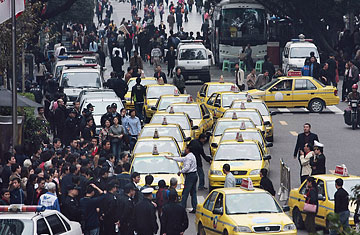
Local residents and police surround taxies parked along a street in Chongqing, China, on Nov. 4, 2008, a day after taxi drivers staged a large protest over increased operating costs, gas shortages, and high traffic fines
By a rough estimate, this was the eighth time in four weeks that taxi drivers around the nation had slammed on their brakes, making the rolling strikes the longest sustained chain reaction of labor unrest in the history of the People's Republic. The strikes are emerging as a test case of a new policy of information control and management instituted by President Hu Jintao that shuns the authorities' traditional emphasis on suppressing bad news altogether and stresses instead using official media to attempt to control how events like strikes, protests and even natural disasters are reported in China. The complex methods Beijing uses to try and dictate what its populace reads, watches and hears about events in their own country are a key element of how the Communist Party maintains power. But as the world economic crisis deepens and unrest becomes more widespread, the central government has had to tweak how it wages its propaganda war. Just how successfully it manages to control the way events unfold will become increasingly critical in preventing isolated cases from turning into the kind of large-scale civil unrest that threatens the party.
On the whole, the rolling taxi strikes have been remarkable for the restraint shown by the authorities, whose response to challenges from below can often be ham-fisted — and brutal. They have also drawn attention for the relatively unfettered coverage given to them in the state media — particularly the first strike in Chongqing when state media, such as the Xinhua News Agency, featured lengthy stories detailing how the local governor and central politburo member Bo Xilai led negotiations to resolve the dispute.
The idea of such guided coverage in the official media was first raised by President Hu in 2007 and given a fresh boost in June when he gave a speech pressing for the party to strengthen guidance of public opinion in both new and old media. "This new policy is happening because these incidents are happening more and more often and they realize they can't control the spread of the news," says David Bandurski, a researcher at the University of Hong Kong's China Media Project. Bandurski says the Chongqing case was a textbook example of the new policy, which he calls "Control 2.0." The government attempts to set the agenda on controversial issues by allowing initial reporting by the likes of Xinhua. At the same time, Beijing bars reporters from the increasingly popular so-called "city papers," which are commercially oriented, tabloid offshoots of hard-line Party papers, such as the People's Daily. These newer papers have to attract readers to survive financially, so they are often in the market for audience-grabbing stories about graft or official malfeasance.
"It's ingenious. The government gets in first with its version of the news," says Bandurski, "and we can surmise that it's accompanied by a propaganda department directive barring the city papers from covering the event so they have to use the official version." Bandurski believes that the credibility of market-oriented papers, like the Southern Metropolis Daily, is significantly higher than that of the older papers, whose readership has been steadily declining for years.
But the continuing wave of taxi strikes underlines a danger that the more upfront coverage of controversial issues carries with it: the danger of copycat incidents in other parts of the country. With the police detaining or jailing leaders of some of the strikes, those involved are understandably reluctant to discuss their motivations. But many observers believe that there is little doubt the lengthy coverage of the strikes in the official media was seen as a form of legitimization by later strikers. "There have been taxi-driver strikes occasionally in the past a few years, but never so many in such a short period of time," says Liu Feiyue of Civil Rights & Livelihood Watch, a Hubei province-based rights group. "There is a domino effect, even though the drivers might deny it. The initial strikes are an inspiration to the later ones."
With other events, the government's tactics have been to dominate the initial coverage and then let the story die a natural death. Normally, "within days the story starts to blow over and there's reader fatigue with it so they move onto to the next story in the news cycle," Bandurski says. "It's very effective." But that method is trickier with an issue like the taxi strikes, which are the result of long-standing grievances — sometimes going back a decade — that have been left largely unaddressed. Unlike other protests, these strikes are not directed specifically against the communist party, which may also explain why the official media has been given freer reins. Still, now that the taxi unrest is a nationwide occurrence, there's no longer much coverage of them in the state press. Indeed, the noticeable drop-off in coverage of is a strong indicator that the cadres who monitor the media have decided the time has come to move on.
But will Chinese be so easily diverted? Some analysts of the Chinese media scene, including the respected former editor Li Datong, have expressed optimism that the new policy could be a sign the government is willing to be more open about allowing wider coverage of sensitive incidents like strikes and environmental disasters. But Bandurski says that, if anything, the opposite is true. In the case of the taxi strikes, there have been no follow-up investigations of the corruption that lies at the root of the issue. "You speak to any working reporter and they'll tell you that control is getting tighter," says Bandurski. "Even on the editorial pages, which traditionally used to be a place some of these issues could be teased out. There's nothing. It's worrying. Even chilling."
